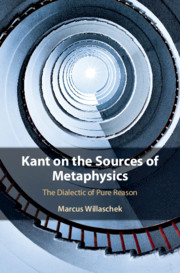Book contents
- Kant on the Sources of Metaphysics
- Kant on the Sources of Metaphysics
- Copyright page
- Dedication
- Contents
- Note on References and Citations
- Preface
- Introduction
- Part I From Reason to Metaphysics
- Introduction to Part I
- 1 Kant’s Conceptions of Reason and Metaphysics
- 2 The Logical Use of Reason and the Logical Maxim
- 3 The Supreme Principle of Pure Reason
- 4 Understanding the Transition Passage (A307–8/B364)
- 5 The Transition from the Logical Maxim to the Supreme Principle of Pure Reason
- Conclusion to Part I: The Transition from the Logical Maxim to the (Constitutive) Supreme Principle and the Rational Sources Account
- Part II The Other Side of the Transcendental Dialectic
- Postscript
- Bibliography
- Index of Names
- Index of Subjects
5 - The Transition from the Logical Maxim to the Supreme Principle of Pure Reason
from Part I - From Reason to Metaphysics
Published online by Cambridge University Press: 09 November 2018
- Kant on the Sources of Metaphysics
- Kant on the Sources of Metaphysics
- Copyright page
- Dedication
- Contents
- Note on References and Citations
- Preface
- Introduction
- Part I From Reason to Metaphysics
- Introduction to Part I
- 1 Kant’s Conceptions of Reason and Metaphysics
- 2 The Logical Use of Reason and the Logical Maxim
- 3 The Supreme Principle of Pure Reason
- 4 Understanding the Transition Passage (A307–8/B364)
- 5 The Transition from the Logical Maxim to the Supreme Principle of Pure Reason
- Conclusion to Part I: The Transition from the Logical Maxim to the (Constitutive) Supreme Principle and the Rational Sources Account
- Part II The Other Side of the Transcendental Dialectic
- Postscript
- Bibliography
- Index of Names
- Index of Subjects
Summary
To understand why rational thinkers, according to Kant, are naturally led to accept the Supreme Principle as true, we must answer two questions: why does the Logical Maxim have to become a principle of pure reason – that is, why is it rationally necessary to make regulative use of the Supreme Principle? And why does this lead to the illusion that the Supreme Principle is an objectively valid constitutive principle (i.e., a true descriptive statement about everything there is)? Chapter 5 offers answers to these questions. The latter question in particular requires a discussion of Kant’s account of transcendental illusion and the role of transcendental realism in bringing about this kind of illusion. The central idea is that transcendental realism implies that there is a correspondence between reason and reality; therefore, a tacit commitment to transcendental realism can explain why regulative principles of reason will naturally be taken to be constitutive principles that are true descriptions of reality itself. Even though transcendental realism is a weighty metaphysical claim, it can plausibly be attributed to common sense or ‘universal human reason.’ The chapter closes with a discussion of why, according to Kant, the Supreme Principle is valid for things in themselves.
Keywords
- Type
- Chapter
- Information
- Kant on the Sources of MetaphysicsThe Dialectic of Pure Reason, pp. 127 - 156Publisher: Cambridge University PressPrint publication year: 2018



